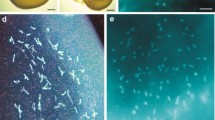Summary
Analysis of the meiotic configurations formed by the three No 21 chromosomes in oocytes from two trisomy 21 foetuses was undertaken using a spreading technique. Light microscope analysis of the first gave limited resolving power, such that over half the oocytes could not be classified as to presence or absence of trivalent or bivalent plusunivalent. In the second, investigated at the electron microscope level, all 65 cells analysed were informative and precise detail of meiotic pairing in trivalents could be obtained. Two principal forms of trivalent occurred, one in which pairing was initiated at opposite ends of the three No 21's, each initiation point involving only two of the three homologous lateral elements; the other in which pairing was initiated by all three elements at the same end, a triple synaptonemal complex being formed. Only in one oocyte out of the 65 analysed at EM level, however, did triple pairing occur along the entire length of the No 21 trivalent. All others showed splitting into bivalent and univalent at some point along the structure. Unpaired regions within trivalents and all univalents were consistently seen to be thickened and dark staining with silver over the whole period from pachytene to diplotene. This contrasted with the desynapsing lateral elements of previously paired synaptonemal complexes which appeared thin by comparison at diplotene. The significance of the thickening remains, as yet, obscure.
Similar content being viewed by others
References
Baker TG (1963) A quantitative and cytological study of germ cells in human ovaries. Proc R Soc B 158:417–433
Baker TG, Franchi LL (1967) The fine structure of oogonia and oocytes in human ovaries. J Cell Sci 2:213–224
de Boer P, van Beek MEAB (1982) Meiosis of T70H translocation male mice. I. Meiotic configurations and segregation. Chromosoma 87:303–313
Comings DE, Okada TA (1971) Triple chromosome pairing in triploid chickens. Nature 231:119–121
Darlington CD (1965) Cytology, 3rd ed. J. and A. Churchill, London
Fletcher JM (1979) Light microscope analysis of meiotic prophase chromosomes by silver staining. Chromosoma 72:241–248
Hultén M, Lindsten J (1970) The behaviour of structural aberrations at male meiosis. Information from man. In: Jacobs PA, Price WH, Law P (eds) Human population cytogenetics. Pfizer Medical Monographs 5, Edinburgh University Press, pp 24–61
Hungerford DA, Mellmann WJ, Balaban GB, LaBadie GU, Messatzzia LR, Haller G (1970) Chromosome structure and function in man. III. Pachytene analysis and identification of the supernumerary chromosome in a case of Down's syndrome (mongolism). Proc Natl Acad Sci USA 67:221–224
Johannisson R, Gropp A, Winking H, Coerdt W, Rehder H, Schwinger E (1983) Down's syndrome in the male. Reproductive pathology and meiotic studies. Hum Genet 63:132–138
Kjessler B, de la Chapelle A (1971) Meiosis and spermatogenesis in two post pubertal males with Down's syndrome: 47,XY,G+. Clin Genet 2:50–57
Luciani JM, Devictor M, Boué J, Morazzani M-R, Boué A, Stahl A (1978) Étude de la méiose ovocytaire chez un foetus trisomique 18. Comportement du chromosome surnuméraire et identification du bivalent 18. Ann Génét 21:215–218
Luciani JM, Devictor M, Morazzani M-R, Stahl A (1976) Meiosis of trisomy 21 in the human pachytene oocyte. Behaviour of the supernumerary chromosome, identification of chromosome sequence and numerous sub-bands. Chromosoma 57:155–163
Luciani JM, Stahl A (1971) Étude des stades de début de la méiose chez l'ovocyte foetal humain. Bull Ass Anat (Nancy) 151:445–458
Manotaya T, Potter EL (1963) Oocytes in prophase of meiosis from squash preparations of human fetal ovaries. Fertil Steril 14: 378–392
Moses MJ (1977) Microspreading and the synaptonemal complex in cytogenetic studies. In: Chapelle de la, Sorsa M (eds) Chromosomes today, vol 6. Elsevier, North-Holland, pp 71–82
Moses MJ (1980) New cytogenetic studies on mammalian meiosis. In: Serio M, Martini L (eds) Animal models in human reproduction. Raven Press, New York, pp 169–190
Moses MJ, Counce SJ, Paulson DF (1975) Synaptonemal complex compliments of man in spreads of spermatocytes with detail of the sex chromosome pair. Science 187:363–365
Moses MJ, Poorman PA, Polani PA, Crolla JA, Moir F (1982) Synapsis, synaptic adjustment and DNA synthesis in meiotic prophase of mouse oocytes. J Cell Biol 95:77a
Rasmussen SW, Holm PB, Lu BC, Zickler D, Sage J (1981) Synaptonemal complex formation and distribution of recombination nodules in pachytene trivalents of triploid Coprinus cinereus. Carlsberg Res Commun 46:347–360
Schröder J, Lydecken K, de la Chapelle A (1971) Meiosis and spermatogenesis in G-trisomic males. Humangenetik 13:15–24
Solari AJ (1980) Synaptonemal complexes and associated structures in microspread human spermatocytes. Chromosoma 81:315–337
Speed RM (1982) Meiosis in the foetal mouse ovary. I. An analysis at the light microscope level using surface-spreading. Chromosoma 85:427–437
Speed RM, Chandley AC (1983) Meiosis in the foetal mouse ovary. II. Oocyte development and age-related aneuploidy. Does a production line exist? Chromosoma 88:184–189
Sybenga J (1975) Meiotic configurations. Springer, Berlin Heidelberg New York
Tres LL (1977) Extensive pairing of the XY bivalent in mouse spermatocytes as visualized by whole-mount electron microscopy. J Cell Sci 25:1–15
Wallace BMN, Hultén MA (1983) Triple chromosome synapsis in oocytes from a human foetus with trisomy 21. Ann Hum Genet 47:271–276
Author information
Authors and Affiliations
Rights and permissions
About this article
Cite this article
Speed, R.M. Meiotic configurations in female trisomy 21 foetuses. Hum Genet 66, 176–180 (1984). https://doi.org/10.1007/BF00286596
Received:
Issue Date:
DOI: https://doi.org/10.1007/BF00286596




